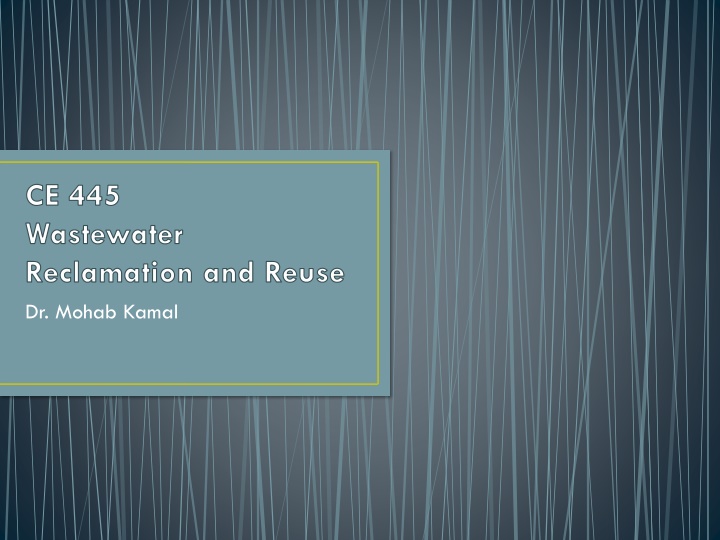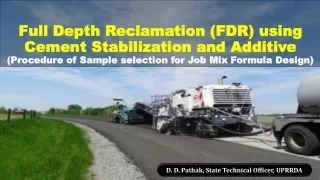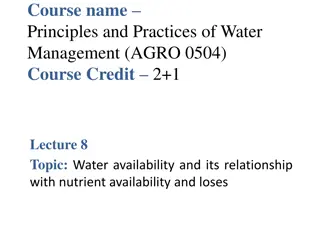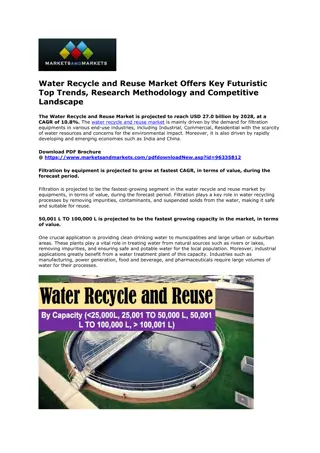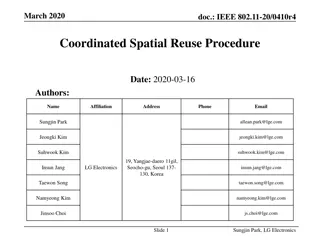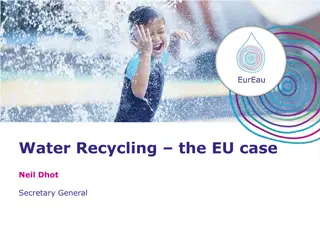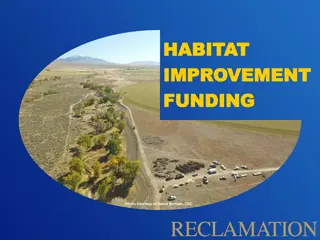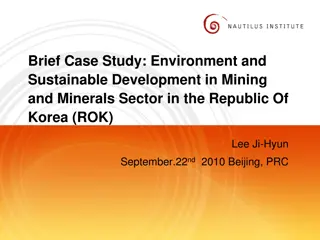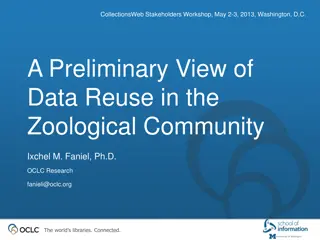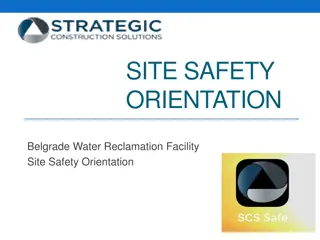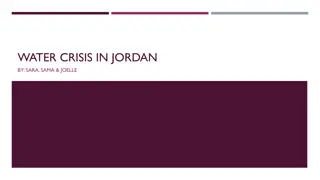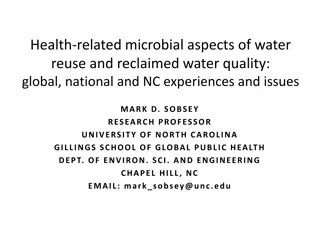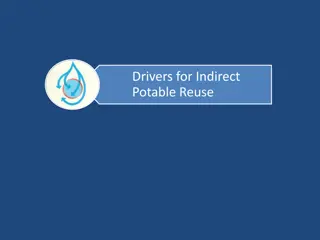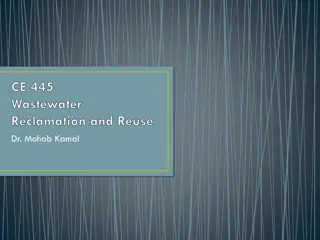Design Principles for Water Reclamation and Reuse
Achieving consistent reclaimed water quality requires proper treatment strategies, technical controls, online monitoring, and operational controls. The design principles focus on elements like monitoring, attenuation, retention, and blending to ensure water quality for various reuse applications. Water quality monitoring is crucial, with a combination of online devices and discrete measurements. Retention post-treatment may enhance contaminant attenuation but can be cost-prohibitive for potable reuse projects.
Download Presentation

Please find below an Image/Link to download the presentation.
The content on the website is provided AS IS for your information and personal use only. It may not be sold, licensed, or shared on other websites without obtaining consent from the author.If you encounter any issues during the download, it is possible that the publisher has removed the file from their server.
You are allowed to download the files provided on this website for personal or commercial use, subject to the condition that they are used lawfully. All files are the property of their respective owners.
The content on the website is provided AS IS for your information and personal use only. It may not be sold, licensed, or shared on other websites without obtaining consent from the author.
E N D
Presentation Transcript
CE 445 Wastewater Reclamation and Reuse Dr. Mohab Kamal
Ensuring Water Quality in Water Reclamation A consistent reclaimed water quality can be achieved through appropriate treatment strategies (e.g., high-level disinfection, process redundancy), technical controls (e.g., alarm shutdowns, frequent inspection procedures), online monitoring devices (e.g., effluent turbidity, residual chlorine concentration), and/or operational controls to react to upsets and variability. This section discusses the state of the science of water reuse design and operational principles to ensure water quality. CE 445 Water Reclamation and Reuse (Dr. Mohab Kamal) 2
DESIGN PRINCIPLES TO ENSURE QUALITY AND RELIABILITY The primary goal of any reuse project is that public health is protected continually and the finished water quality is acceptable to consumers. Four elements monitoring, attenuation, retention, and blending are typically embedded into the design of both nonpotable and potable reuse schemes to ensure a reclaimed water quality that is suitable for the desired use at all times. CE 445 Water Reclamation and Reuse (Dr. Mohab Kamal) 3
DESIGN PRINCIPLES TO ENSURE QUALITY AND RELIABILITY The extent of monitoring, contaminant attenuation, retention, and blending required for a particular water reuse application (e.g., industrial, agricultural, potable) will depend on project- specific water quality objectives and the potential impacts from system failure. The following discussions focus primarily on potable reuse applications, for which rigorous quality assurance is essential, although the design concepts can be adapted to nonpotable applications as well. CE 445 Water Reclamation and Reuse (Dr. Mohab Kamal) 4
Water Quality Monitoring As with conventional drinking water supplies, water quality monitoring for potable water reuse is composed of a combination of online monitoring devices (e.g., filter effluent turbidity, chlorine residual, pH) and discrete measurements using grab or composite samples (e.g., ammonia, nitrate, dissolved organic carbon [DOC], Eschericia coli) to ensure the quality of the finished product water. These practices usually follow standards and protocols similar to those applied in drinking water treatment. Although these monitoring controls can fail, the acknowledged imperfection of the monitoring technology is comparable to that of drinking water treatment facilities. CE 445 Water Reclamation and Reuse (Dr. Mohab Kamal) 5
Water Quality Monitoring In some cases potable reuse systems are required to include water retention after discharge from the treatment plant (e.g., in surface or subsurface storage of the product water). In theory, this retention allows time for additional contaminant attenuation and for water to be diverted from the distribution system if water quality problems are detected. However, significant water retention is often not cost-effective for potable reuse projects. Additionally, past experience with water reuse has demonstrated that unanticipated contaminants can be detected in final product water, even when state-of-the-art treatment and monitoring programs are employed CE 445 Water Reclamation and Reuse (Dr. Mohab Kamal) 6
Water Quality Monitoring An idealized monitoring program would measure critical microbial and chemical contaminants in real time in the finished product water before it leaves the reclamation plant. The availability of instantaneous monitoring techniques could allow significant reduction of required reclaimed water retention times. Water quality goals would need to be well defined, and measuring techniques would need to be selected with sensitivity suitable for confirming that water treatment goals have been achieved. CE 445 Water Reclamation and Reuse (Dr. Mohab Kamal) 7
Water Quality Monitoring Also, to be truly protective of public health, such monitoring programs would need to be comprehensive enough to include all potential contaminants that pose significant risks in the anticipated reuse applications. Real-time monitoring techniques that are both sufficiently comprehensive and sensitive are unlikely to be available in the next decade. Thus, in the meantime, alternative approaches to quality assurance are needed to address shortcomings in real- time monitoring of contaminants. CE 445 Water Reclamation and Reuse (Dr. Mohab Kamal) 8
Water Quality Monitoring Where drinking water is concerned, this need has been addressed by a three-part strategy: (1) characterizing critical elements that control the performance of unit processes in removing specific contaminants, (2) identifying parameters that can be reliably monitored and used to confirm that these elements are in place and that the processes are performing as expected, and (3) routine analysis of certain constituents in samples taken from the finished water to confirm that the previous measures are reliable. Recently, a monitoring approach with similar components has been proposed for management of trace organic chemicals in potable reuse schemes (Drewes et al., 2008). CE 445 Water Reclamation and Reuse (Dr. Mohab Kamal) 9
Water Quality Monitoring This approach combines the monitoring of bulk parameters (i.e., surrogates) and a select number of indicator chemicals to ensure proper performance of unit processes. In this work, performance indicators and surrogate parameters are defined as follows: Indicator An indicator compound is an individual chemical occurring at a quantifiable level, that represents certain physicochemical and biodegradable characteristics of a family of trace organic constituents that are relevant to fate and transport during treatment. It provides a conservative assessment of removal. (Drewes et al., 2008). Surrogate A surrogate parameter is a quantifiable change of a bulk parameter that can measure the performance of individual unit processes or operations in removing trace organic compounds (Drewes et al., 2008). Surrogates can often be used in real time. As an analogy, the measurement of indicators plays a similar role to the measurement of E. coli in drinking water, and the monitoring of surrogates plays a role similar to the monitoring of chlorine residual and contact time. CE 445 Water Reclamation and Reuse (Dr. Mohab Kamal) 10
Water Quality Monitoring Monitoring requirements usually become more stringent (e.g., more frequent sampling and more constituents to be monitored) as the potential for human contact with the reclaimed water increases. Municipal wastewater can contain thousands of chemicals originating from consumer products (e.g., household chemicals, personal care products, pharmaceutical residues), human waste (e.g., natural hormones), industrial and commercial discharges (e.g., solvents, metals), or chemicals that are generated during water treatment. Thus, it is appropriate for monitoring programs for reclaimed water used for potable applications to be more comprehensive than programs commonly used for monitoring water quality for conventional drinking water supplies. CE 445 Water Reclamation and Reuse (Dr. Mohab Kamal) 11
Attenuation Attenuation of microbial and chemical contaminants of concern can be achieved by establishing multiple barriers. A reuse scheme usually is composed of a combination of treatment barriers that are suitable to reduce the concentrations of compounds of concern and preventive measures that control exposure to certain contaminants, although the actual number of barriers differs among different reuse projects. Tailored source control programs that limit the discharge from industrial activities to a municipal sewer system or the maintenance of a reclaimed water distribution system are examples of preventive barriers. Attenuation of water quality constituents of concern can occur through conventional wastewater treatment, advanced water treatment, or engineered natural systems. CE 445 Water Reclamation and Reuse (Dr. Mohab Kamal) 12
Attenuation Multiple barriers are an important concept in ensuring that performance goals are met. Multiple barriers accomplish this objective in two ways: (1) by expanding the variety of contaminants the process train can effectively address (i.e., robustness) and (2) by improving the degree to which the process can be relied upon to remove any one of them (i.e., reliability, or the extent of consistent performance of a unit process to attenuate a contaminant). Multiple barriers can also provide redundancy (defined as a series of unit processes that is capable of attenuating the same type of contaminant) so that if one process fails another is still in the line. CE 445 Water Reclamation and Reuse (Dr. Mohab Kamal) 13
Attenuation Given the nature of the associated risk, the performance criteria of multiple barriers are generally different for pathogens, which can cause acute (sudden and severe) health effects, as compared with organic chemicals, which can cause chronic health effects after prolonged or repeated exposures in drinking water scenarios CE 445 Water Reclamation and Reuse (Dr. Mohab Kamal) 14
Retention Within a water reuse context, retention time may serve two purposes: (1) to allow additional opportunities for attenuation of contaminants and (2) to provide time to respond to system failures or upsets. Retention time can be provided by storing reclaimed water in a surface storage reservoir, storing it in an engineered storage tank, recharging it to an unconfined or confined aquifer, releasing it into a segment of a river, or conveying it through a pipeline system. Proper documentation should be provided of how the water provider would be able to respond to specific types of upsets, including strategies for diverting compromised product water to avoid contaminated water reaching consumers and to ensure that the desired retention time is actually provided. CE 445 Water Reclamation and Reuse (Dr. Mohab Kamal) 15
Blending Blending of reclaimed water with a water source other than wastewater (e.g., surface water, stormwater, native groundwater) may occur prior to treatment of reclaimed water in engineered processes or after treatment prior to a distribution system. For advanced treatment processes that demineralize reclaimed water and remove trace chemicals, it may be necessary to balance the water chemistry by blending after treatment for public health concerns (e.g., absence of magnesium and calcium), to enhance taste, to prevent downstream corrosion (e.g., calcium saturation index), and to minimize damage to soils (e.g., sodium adsorption ratio) and crops (e.g., magnesium deficiency) (Tchobanoglous et al., 2011). Blending with traditional sources can also ensure some degree of contaminant dilution if a treatment system failure occurs. It is noteworthy that in many cases the blending water might actually represent a lower quality source. Therefore, a careful evaluation of the water quality prior to and after blending is warranted to avoid any degradation of the final product water. CE 445 Water Reclamation and Reuse (Dr. Mohab Kamal) 16
Case Studies for System Design Case Study 1 Case Study 1 describes a groundwater recharge project favoring direct injection of reclaimed water into a potable aquifer after advanced treatment. CE 445 Water Reclamation and Reuse (Dr. Mohab Kamal) 17
Case Studies for System Design Case Study 2 Case Study 2 illustrates a groundwater recharge project employing surface spreading followed by soil aquifer treatment. CE 445 Water Reclamation and Reuse (Dr. Mohab Kamal) 18
Case Studies for System Design Case Study 3 Case study 3 represents a groundwater recharge scenario using a combination of engineered natural treatment systems with advanced engineered unit processes for drinking water augmentation CE 445 Water Reclamation and Reuse (Dr. Mohab Kamal) 19
STEPS TO ENSURE WATER QUALITY IN WATER REUSE These steps address potential public health impacts from microbial pathogens and chemical contaminants found or likely to be found in reclaimed water and include considerations of reliability and quality assurance, and therefore merit careful consideration from designers and managers of reuse projects. The extent of each activity will depend on the type of reuse (nonpotable vs. potable) and degree of exposure. CE 445 Water Reclamation and Reuse (Dr. Mohab Kamal) 20
STEPS TO ENSURE WATER QUALITY IN WATER REUSE 1. Implement and maintain an effective source control program. 2. Utilize the most appropriate technology in wastewater treatment that is tailored to site-specific conditions. 3. Utilize multiple, independent barriers, especially for the removal of microbiological and organic chemical contaminants. 4. Employ quantitative reliability assessments to monitor and assess performance including major and minor process failures (i.e., both process control and final water quality monitoring and assessment as well as assessment of mechanical reliability). 5. Establish a trace organic chemical monitoring program that goes beyond currently regulated contaminants. CE 445 Water Reclamation and Reuse (Dr. Mohab Kamal) 21
STEPS TO ENSURE WATER QUALITY IN WATER REUSE 6. Document a strategy to provide retention time necessary to allow time to respond to system failures or upsets (e.g., this could be based, in part, on turnaround time to receive water quality monitoring results). Provide for alternative means for diverting the product water that does not meet required standards. Avoid short-circuiting in environmental buffers to ensure maintenance of appropriate retention times within the buffers (i.e., groundwater, wetlands, reservoir). Train and certify operators of advanced water reclamation facilities regarding the principles of operation of advanced treatment processes, and educate them on the pathogenic organisms and chemical contaminants likely to be found in wastewaters and the relative effectiveness of the various treatment processes in reducing microbial and chemical contaminants concentrations. 10. Institute formal channels of coordination between water reclamation agencies, regulatory agencies, and agencies responsible for public water systems. 7. 8. 9. CE 445 Water Reclamation and Reuse (Dr. Mohab Kamal) 22
